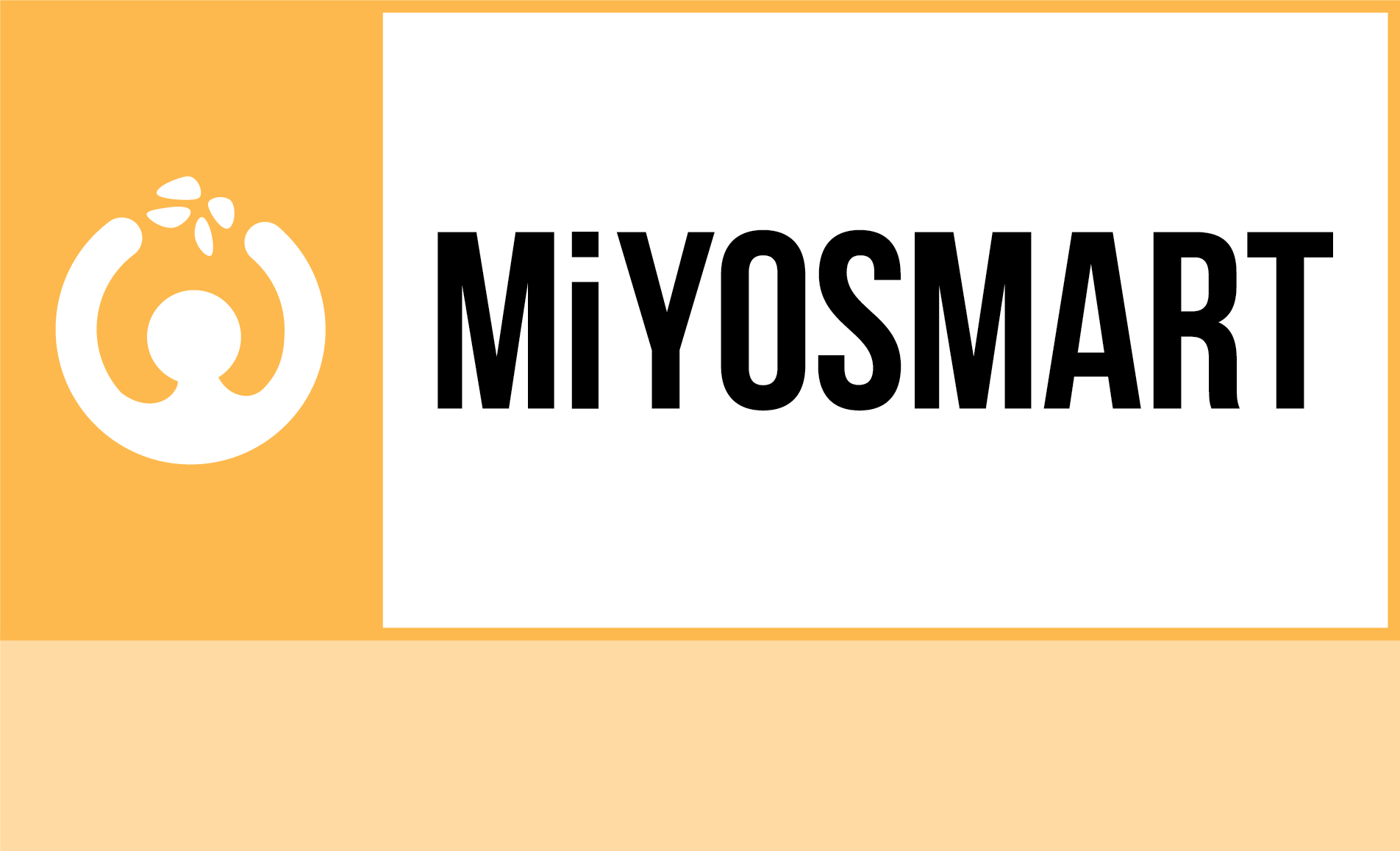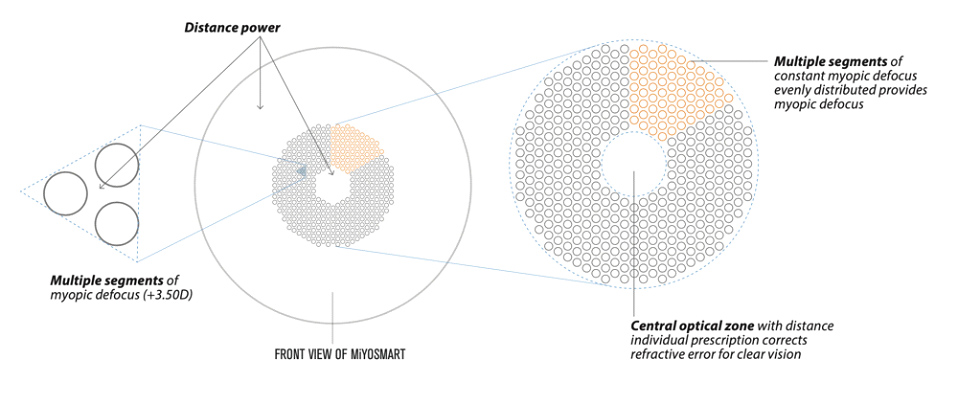What are Miyosmart and Stellest spectacle lenses?
These are new and revolutionary spectacle lenses for slowing the progression and deterioration of myopia in children. But before you arrange a fitting for your child, you must be aware of all the factors that contribute to your child’s myopia, when Miyosmart or Stellest lenses are NOT suitable for your child. And more importantly, does your Optometrist know ALL the facts?
Find out more about myopia and how to control its progression

How do Miyosmart and Stellest lenses work?
These lenses work their magic through an optical effect called peripheral defocus. This means that the peripheral part of the lens has a different focus than the central portion of the lens. The eye detects the focus at the peripheral part of the retina (the film inside the eyes that sees light) and depending on the focus, can influence the speed of growth of the eyeball. These lenses help to slow the growth of the eyeball, and in turn, grow the deterioration of the myopia. Hoya, the company that makes Miyosmart lenses call their technology DIMS (Defocus Incorporated Multiple Segments) and Essilor who make Stellest lenses call their technology HALT (Highly Aspherical Lenslet Target). Both types of technology induce a similar defocus effect when worn.

What are the causes of myopia?
Myopia (also known as short-sightedness) is a complicated condition that has the potential to have a life-long impact on a child’s life and vision. From struggles when reading the board at school and low confidence when growing up to a high risk of sight-threatening diseases of the eye as an adult.
What is the importance of myopia management?
Without a doubt, there is an urgency in slowing the progression of myopia as soon as possible. But to be able to slow the rate of myopia you have to understand all of the factors. Many optometrists and opticians may be fitting children with these lenses without adequately assessing all of the relevant elements or being fully aware of these factors.
As Myopia Management Practice of the Year 2022 in the UK and one of the largest providers of Miyosmart lenses in the UK, we wanted to provide parents with the information they need when embarking on a programme of myopia management for their kids, especially when using Miyosmart lenses.
Four major factors play a part in myopia in children.
- Genetic: if you are myopic, your child has a 3 times higher chance of being myopic.
- Environmental: not spending enough time outdoors and too much time indoors especially doing lots of reading or using can increase the risk and progression of myopia.
- Optical factors: As our eyes grow, we become more short-sighted. There are optical focus factors that drive an increase in eyeball growth which leads to further progression. Lenses such as Miyosmart create modified optical focus (peripheral defocus) in the eye to try and neutralise these factors.
- Visual skills: Accommodation (focusing) and Binocular Vision (coordinated movement and control of the eyes): Difficulties or weaknesses in these visual skills can influence myopia.
What needs to be assessed BEFORE you start myopia management with Miyosmart?
Accommodation and Binocular vision disorders are frequently overlooked by practitioners, yet they are major factors in myopia. All children with myopia must have a thorough assessment of these visual skills. A significant proportion of the children we are treating for myopia also have difficulties with focusing or binocular vision. All myopia control programmes must carefully and thoroughly assess the binocular vision and focusing (accommodation) ability of the eye and visual system.
Even MORE important. If your child has difficulty, what therapy options are available to improve visual skills? Ask about the treatment plan. Ensure your optometrist gives you a clear course of action related to any findings and reviews issues regularly.
The length of the eyeball (the axial length) is a crucial factor in determining the rate of progression of myopia and the risk of serious complications in later life. We use advanced equipment to monitor the rate of increase in the size of the eyeball and therefore the effectiveness of the treatment.
Is your child offered the best fitting spectacle frame for them?
Your child needs to be looking through a small and specific central zone of the lenses. We have seen cases from some optical practices where the frame isn't fitting the child properly. The child isn't looking through the right zone of the lens or the frame keeps slipping or sliding down the child's nose which means that the child does not see as clearly as they should and makes the lenses less effective at myopia management.
Children's faces, especially the bridge of their nose, develops after 8 to 10 years of age. Some children develop sooner than others and there is a wide variety of measurements and sizes. We have a range of children's frames that are designed to fit a child's face and features for this age. They are highly adjustable and customisable to fit the diversity of development in children's faces. This means your child will have clear, stable vision and their lenses will provide the most effective myopia management.
What are the cases when a child is NOT suitable for Miyosmart or Stellest lenses?
It is essential to address the following reasons before fitting and dispensing these lenses:
- Severe myopia: Children with severe myopia may not be good candidates for these lenses due to the available power ranges for these lenses.
- Amblyopia or "lazy eye": Children with amblyopia or "lazy eye" may not be good candidates.
- Other eye conditions: Children with other eye conditions such as strabismus (crossed eyes), or nystagmus (involuntary eye movements) may not be good candidates for peripheral defocus design lenses because the blur in the peripheral part of the lens
- Poor visual acuity: Children with poor visual acuity may not be good candidates for peripheral defocus design lenses because the blur in the peripheral part of the lens may make it difficult for them to see.
- Very young age: Children who are myopic before the age of 5 need to be careful to check the cause of their myopia because there are often factors involved for those who are very young
- Difficulty adapting to new vision correction methods: Some children may have difficulties with sensory processing or adapting to new vision correction methods. This includes the sensation of wearing glasses or the vision with peripheral defocus design lenses and may experience discomfort or difficulty with them.
- Those who don’t wear their glasses consistently: These lenses need to be worn most of the time to ensure clear vision and effective treatment. There are some children who, for several reasons, do not wear their glasses consistently. Understanding your child’s motivation and wearing their glasses is important.
- Children who can’t return for follow-ups and monitoring appointments: Regular check-ups and monitoring are essential. Your practitioner must have a regular and established regime for follow-ups to monitor your child as they grow.
- A history of keratoconus or other corneal diseases: Children who have a history of keratoconus (a condition that causes progressive distortion of the front surface of the eye) or other corneal diseases may not be good candidates for peripheral defocus design lenses and require regular monitoring.
As part of our initial myopia management assessment and consultation, we investigate all these plus much more.
Are you offered any other methods of myopia management?
We use at least 5 different types of spectacle lenses for myopia management and 7 different types of contact lenses to offer one of the most comprehensive myopia management programmes in the UK. Have you been offered any alternatives or advised that alternatives exist?
Have you been told about the benefits of contact lenses for myopia management?
About 15% of the children we see for myopia management use Miyosmart spectacle lenses. However, the other 85% use specialist contact lenses to slow the progression of their myopia. We have exceptionally good results with contact lenses for children from the age of 5.
The majority of children prefer wearing contact lenses to glasses. The risk of complications with contact lenses is extremely low. Children have the lowest incidence of issues with contact lenses compared to most other age groups, even young adults.
Our amazing results
Our Myopia Management Programme incorporates regular assessment and monitoring in conjunction with the Miyosmart or Stellest lenses to provide a complete and comprehensive care plan that’s specific to the needs of your child. We can adapt the treatment plan and regime as your child grows and their needs change. We also have early access to the latest and most advanced methods for myopia management, many before they reach the optical industry. So your child will have the best and most active myopia management programme in the UK.
Please call us on 02083431122 or send us email: [email protected]

